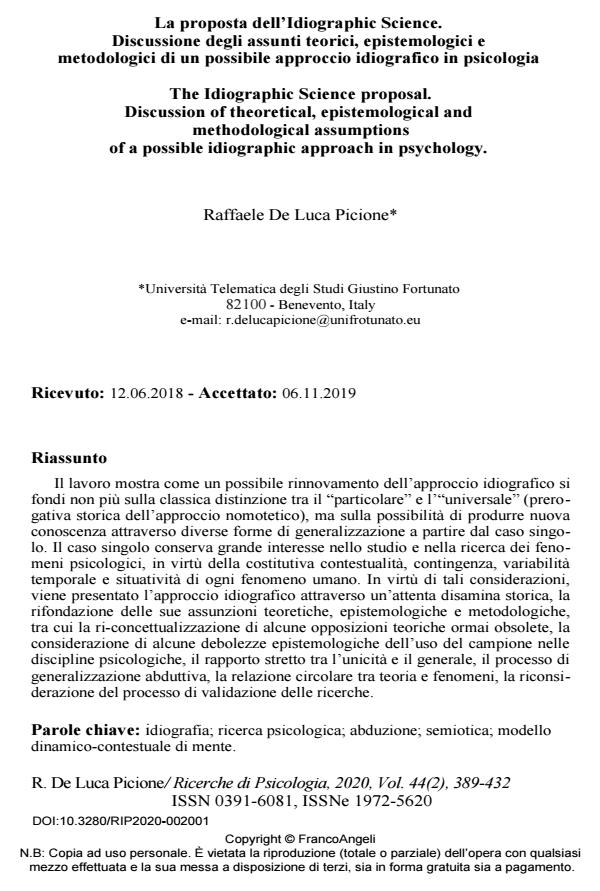The Idiographic Science proposal. Discussion of theoretical, epistemological and methodological assumptions of a possible idiographic approach in psychology
Journal title RICERCHE DI PSICOLOGIA
Author/s Raffaele De Luca Picione
Publishing Year 2020 Issue 2020/2
Language Italian Pages 44 P. 389-432 File size 436 KB
DOI 10.3280/RIP2020-002001
DOI is like a bar code for intellectual property: to have more infomation
click here
Below, you can see the article first page
If you want to buy this article in PDF format, you can do it, following the instructions to buy download credits

FrancoAngeli is member of Publishers International Linking Association, Inc (PILA), a not-for-profit association which run the CrossRef service enabling links to and from online scholarly content.
The paper presents how a possible renewal of the idiographic approach is based no more on the classic distinction between the "particular" and the "uni-versal" (historical prerogative of the nomothetic approach), but on the possibility of creating new knowledge through different forms of generalization from the single case. The single case maintains great interest in the study and research of psychological phenomena, by virtue of inherent contextuality, contingency, tem-poral variability and situativity of every human phenomenon. Following these considerations, an idiographic approach is presented by means of: a) the re-foundation of its theoretical, epistemological and methodological assumptions, including the re-conceptualization of some obsolete theoretical oppositions; b) aspects of epistemological weakness of the use of the sample in the psychologi-cal disciplines; c) the close relationship between uniqueness and the general; d) the process of abductive generalization; e) the circular relationship between theo-ry and phenomena; f) the reconsideration of the process of validation of research.
Keywords: idiography; psychological research; abduction; semiotics; contex-tual-dynamic mind model
- Handbook of Research on Healthcare Standards, Policies, and Reform Maria Francesca Freda, Raffaele De Luca Picione, Maria Luisa Martino, Daniela Lemmo, Ersilia Auriemma, pp.52 (ISBN:9781799888680)
- Psychoanalytic Study on the Xylella fastidiosa Conspiracy Theory Angelo Maria De Fortuna, Cristiano Scandurra, Vincenzo Bochicchio, Raffaele De Luca Picione, in Human Arenas /2025
DOI: 10.1007/s42087-025-00477-y - Looking at oneself in the mirror of the others. Modelisation and implications of a study on human reflexivity starting from semiotics and psychoanalysis Raffaele De Luca Picione, Pablo Fossa, Maria Elisa Molina, Rosapia Lauro Grotto, in RIVISTA DI PSICOLOGIA CLINICA 1/2022 pp.85
DOI: 10.3280/rpc1-2022oa13976 - Sharing Medical Decisions with the Child. An Exploratory Survey in Paediatric Primary Care. Francesca Dicé, Pasquale Dolce, Assunta Maiello, Maria Francesca Freda, in Child Care in Practice /2024 pp.434
DOI: 10.1080/13575279.2021.1910488 - The Semiotic Paradigm in Psychology. A Mature Weltanschauung for the Definition of Semiotic Mind Raffaele De Luca Picione, in Integrative Psychological and Behavioral Science /2020 pp.639
DOI: 10.1007/s12124-020-09555-y - Ten Years of Idiographic Science Raffaele De Luca Picione, Maria Francesca Freda, pp.47 (ISBN:979-8-88730-028-3)
- Changes of narrative meaning-making markers
during the different phases of breast cancer
treatment for women below 50 years old Maria Luisa Martino, Daniela Lemmo, Anna Gargiulo, Daniela Barberio, Valentina Abate, Franca Avino, Maria Francesca Freda, in Health Psychology Report /2021 pp.58
DOI: 10.5114/hpr.2021.105363 - Metapsychology of borders: Structures, operations and semiotic dynamics Raffaele De Luca Picione, in European Journal of Psychotherapy & Counselling /2021 pp.436
DOI: 10.1080/13642537.2021.2000463
Raffaele De Luca Picione, La proposta dell’Idiographic Science. Discussione degli assunti teorici, epistemologici e metodologici di un possibile approccio idiografico in psicologia in "RICERCHE DI PSICOLOGIA " 2/2020, pp 389-432, DOI: 10.3280/RIP2020-002001